




Your support is critical to our success.
Accepted Scientific Name: Cycas canalis
Telopea 5: 698 1994
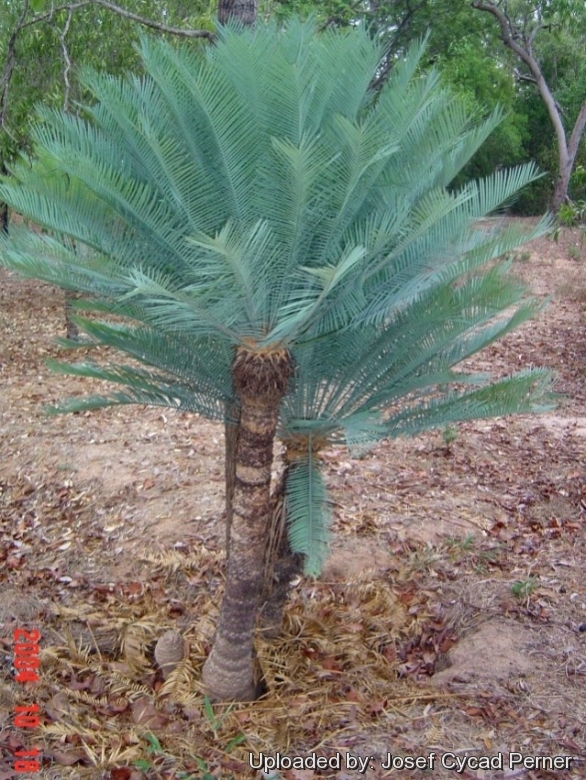
Origin and Habitat: Cycas canalisSN|29958]]SN|29958]] subsp. carinata is a sporadic and scattered taxon, known only inland from west of Dorisvale to around Douglas Daly Reserve, Northern Territory, Australia.
Habit and ecology: This species usually grows on lateritic soil profiles in open forest or woodland with Eucalyptus miniata. Rainfall 800–1200 mm per annum. This climate is warm and hot in the summer with temperatures ranging from 24 to 36°C. The winter is warm and frost-free with temperatures ranging from 12 to 30°C.
Synonyms:
Description: Cycas canalis subsp. carinata is a medium to tall palm-like cycad with slenderer woody trunk to about 3 to 5 m tall topped with an elegant crown of fronds that comes out glaucous bluey-green but turns greener with time and with densely orange-woolly or floccose cataphylls similar to that present in Cycas lanata. C. canalis subsp. carinata is a morphological or southern form occurring inland in the Daly River area near Dorisvale, whereas the standard form (subsp. carinata) occurs only on the coast at Channel Point. This subspecies can be distinguished from C. canalis subsp. canalis by the keeled fronds and the low leaflet-to-rachis angle. Leaves also tend to be longer, with larger leaflets. However the distinguishing characteristics of Cycas canalisSN|29958]]SN|29958]] subsp. carinata, appear to fall within the natural variation of Cycas canalis and the current taxonomic treatment considers this to be a single species with no subspecies.
Derivation of subspecific name: The name derives from "carina", Latin for keel, referring to the keeled (the V-shaped), rather than flat arrangement of leaflets on the rachis.
Stems (trunks): Slender erect, usually unbranched 2-3(-5) m tall, 7-14 cm in diameter.
Leaves (Fronds): Numerous, straight, glaucous blue ageing to bright green, 60-105 cm long, moderately 'v'-shaped (keeled) to flat (not keeled) in section (opposing leaflets inserted at 130-180° on rachis), with 100-170 leaflets, with white and orange tomentum shedding as leaf expands; rachis usually terminated by a spine. Petiole 15-25 cm long, glabrous or slightly orange-tomentose, more or less spiny. Pinnae (leaflets) in 50–85 pairs,100-205 mm long, 4.5-8 mm wide, inserted at 40-90° to rachis. Basal pinnae not gradually reducing to spines.
Cataphylls: The cataphylls (Modified leaf, much reduced and thickened, serving to protect the apical meristem in cycads produced in flushes preceding the emergence of cones or leaves.) are linear, pungent, densely floccose, 70-90 mm long, persistent.
Male cones: Ovoid, green becoming orange at maturity, 15-22 cm long, 8-12 cm in diameter The young microsporophylls are fleshy, but at maturity they become hard and woody. The microsporophyll lamina is firm, 35-45 mm long, 15-23 mm wide. The distal most part and the proximal part of the sporophyll (8-14 mm long) are sterile while the fertile zone (middle surface of abaxial side) is 28-32 mm long and covered with microsporangia. The distal part of the microsporophyll is wedge shape and expanded. The tip of the distal part is pointed and sharply curved upward, 11-18 mm long. The proximal end of the microsporophyll is narrow and stalk like, attached to the cone axis.
Megasporophylls: Like other Cycas species, the female plants do not bear cones; instead they carry ovules and seeds on large, open, grey-tomentose and brown-tomentose megasporophylls which are pendent when mature, l6-25 cm long, with 2-4 ovules. Llamina lanceolate, 40-60 mm long, 22-32 mm wide, toohted, with 12-20 pungent lateral spines 2-6 mm long, 2 mm wide, apical spine distinct from lateral spines, 10-30 mm long.
Seeds: flattened-ovoid, 34-40 mm long, 30-36 mm wide; sarcotesta orange-brown, not pruinose.
Subspecies, varieties, forms and cultivars of plants belonging to the Cycas canalis group
 Cycas canalis K.D.Hill: Leaves flat, 60-90 cm long. Distribution: Coastal.
Cycas canalis K.D.Hill: Leaves flat, 60-90 cm long. Distribution: Coastal. Cycas canalis subs. carinata: same as Cycas canalis but leaves moderately 'v'-shaped, 70-105 cm long. Distribution: Inland.
Cycas canalis subs. carinata: same as Cycas canalis but leaves moderately 'v'-shaped, 70-105 cm long. Distribution: Inland.
Bibliography: Major references and further lectures
1) Patrick M. McCarthy, Anthony E. Orchard.“Flora of Australia. Volume 48., Ferns, Gymnosperms and allied groups, Australian Biological Resources Study” Collingwood, Vic.: CSIRO, 1998.
2) Peter Drahos “Intellectual Property, Indigenous People and their Knowledge” Cambridge University Press, 12 June 2014
3) Ottley, H. 2010. Cycas canalis. The IUCN Red List of Threatened Species 2010: e.T42023A10628338. http://dx.doi.org/10.2305/IUCN.UK.2010-3.RLTS.T42023A10628338.en . Downloaded on 20 October 2015.
4) Whitelock, Loran M., "The Cycads", Timber press, 2002.
5) Haynes J.L, "World List of Cycads: A Historical Review", IUCN/SSC Cycad Specialist Group, 2012.
6) Wikipedia contributors. "Cycas canalis." Wikipedia, The Free Encyclopedia. Wikipedia, The Free Encyclopedia, 24 Dec. 2014. Web. 20 Oct. 2015.
7) The Cycad Pages “Cycas canalis” Royal Botanic Gardens Sydney Written and maintained by Ken Hill 1998-2010 Maintained by Leonie Stanberg and Dennis Stevenson 2010-2012 <http://plantnet.rbgsyd.nsw.gov.au/cgi-bin/cycadpg?taxname=Cycas+canalis> Web. 02 October 2015.
8) Dixon, Dale. "A Review of the Gymnosperms of the Northern Territory" [online]. Beagle: Records of the Museums and Art Galleries of the Northern Territory, The, Vol. 20, Dec 2004: 1-24. Availability: <http://search.informit.com.au/documentSummary;dn=057179884215302;res=IELHSS> ISSN: 0811-3653. [cited 21 Oct 15].
9) Hill, KD “Three new species of Cycas (Cycadaceae) from the Northern Territory, Australia [Cycas arnhemica, C. orientis, C. canalis]” Telopea 54(4): 693-701, 1994.
10) Calonje M, Stevenson DW, Stanberg L. "The World List of Cycads", online edition [Internet]. 2013-2015. [cited 2015 Oct 21]. Available from: http://www.cycadlist.org.
11) "Cycads: Life History and Ecology" <http://www.ucmp.berkeley.edu/seedplants/cycadophyta/cycadlh.html> Web. 25 August 2015
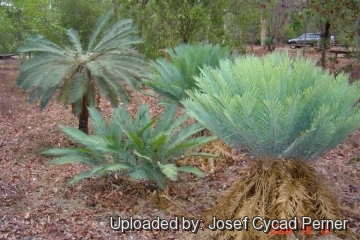
Cycas canalis subs. carinata Photo by: Josef Cycad Perner
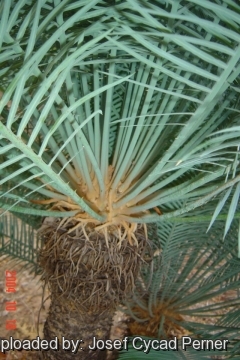
Cycas canalis subs. carinata Photo by: Josef Cycad Perner
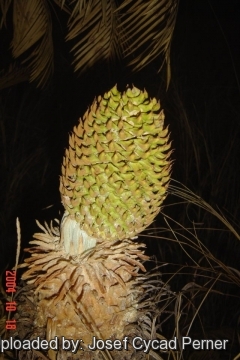
Cycas canalis subs. carinata Photo by: Josef Cycad Perner

Cycas canalis subs. carinata Photo by: Josef Cycad Perner

Cycas canalis subs. carinata Photo by: Josef Cycad Perner
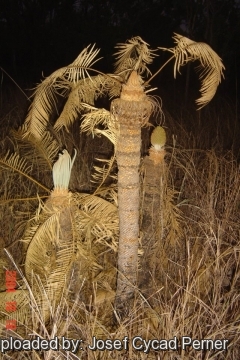
Cycas canalis subs. carinata Photo by: Josef Cycad Perner
Cultivation and Propagation: Cycas canalisSN|29958]]SN|29958]] is suited to tropical regions which have a seasonally dry climate. It is easy to grow, tolerating dry periods, but up to the time of this writing this species is not common in cultivation. Cycas couttsianaSN|31952]]SN|31952]] has a nice appearance and may make a good garden or landscape planted in the ground or a deep pot so its fast-growing taproot room can develop properly. Benefits of this plant include high tolerance to sun, drought, heat and cold.
Growth rate: Usually slow growing, however good conditions can speed it up considerably. Because of its growth habit, fertilize only when terminal bud begins to swell, indicating the start of the annual growth cycle.
Exposure: It prefers bright light exposure; best with some protection from afternoon heat.
Soil: Needs a well drained spot, with deep soil, but will still thrive in less than ideal conditions.
Maintenance: Minimal; removal of offsets if desired, removal of spent fronds.
Use: Landscape as cultivated perennial in warm, coastal areas; House-plant or interior-scape, as container plant in cool areas, as well very well suited to bonsai culture.
Traditional uses:The seeds of Cycas canalisSN|29958]]SN|29958]] (bush palm) is poisonous, but can be turned into a damper that has the qualities of long-term storage and high food energy. The flour is used to make tortillas, tamales, soup and porridge. However, consumption of the flour may result in a neurological disorder because of the neurotoxins content.
Propagation: Seed or offshoots (or "pups"). The advantage of the "pups" is that you will know its sex, for seedlings you will have to wait several years until the plant flowers to find out. After fertile seeds are collected, they usually need several months of storage before the inner embryo is ready to germinate. Therefore, it is best to clean the seeds of external fruit and set them aside before attempting to propagate the seeds.
| Your Actions | |
|---|---|
| Back to Cycas index | |
| Back to Cycadaceae index | |
 |
Back to Palms And Cycads Encyclopedia index |
Privacy stantement - Terms and conditions - How to cite - About us - Feedback - Donate


